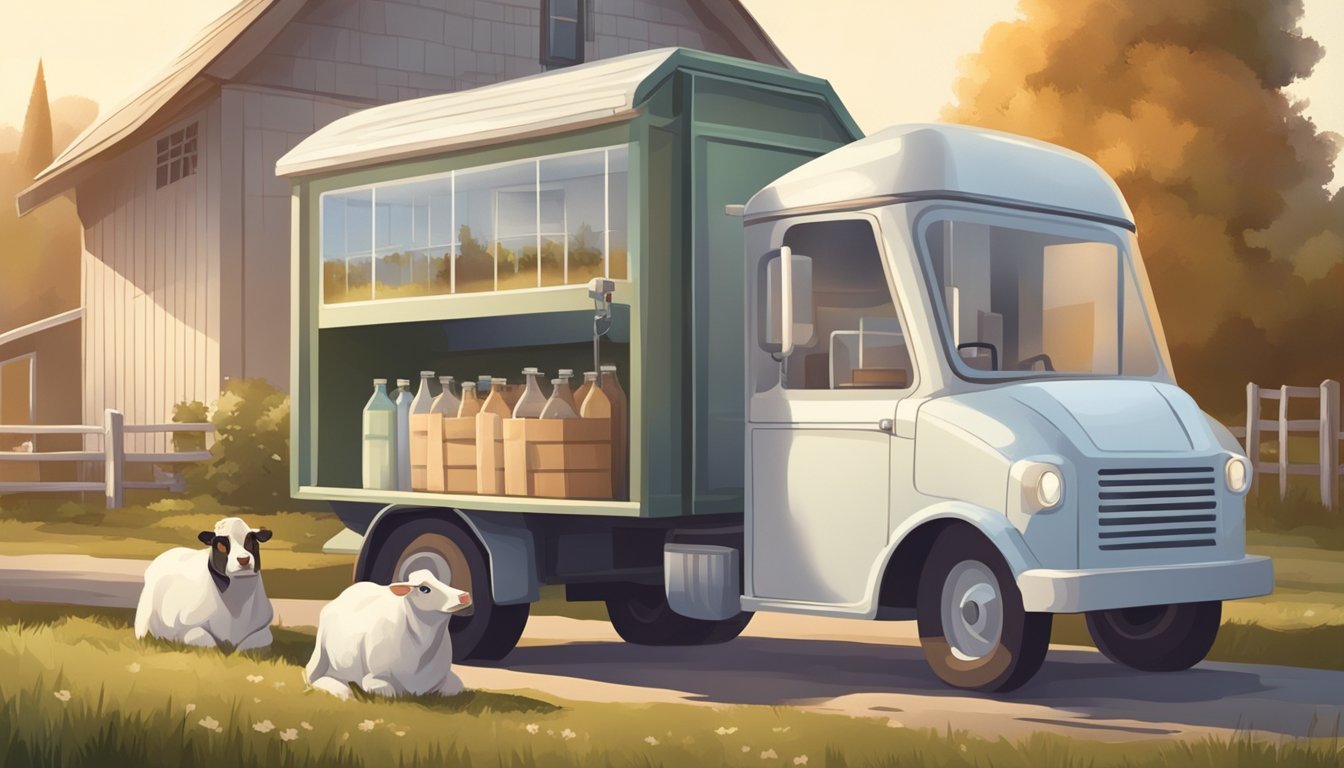The Revival of Raw Milk Delivery Services
Embracing Tradition in Modern Times
he resurgence of milk delivery services is tapping into a wave of nostalgia, reviving a tradition that connects consumers to a simpler, bygone era. This revival is characterized by a particular interest in raw milk—a product that has maintained a dedicated, though niche, following. As customers increasingly seek out more natural and unprocessed foods, raw milk, with its perceived health benefits, has become a focal point. Milk delivery services, once a common sight in neighborhoods with the local milkman making his rounds, are now being rejuvenated to meet this contemporary demand, merging the pastoral imagery of the past with the conveniences of modern e-commerce.
In states where the sale of raw milk is permitted, there has been a notable increase in the number of state-sanctioned raw-dairy farms, as well as a rise in what some describe as black-market delivery clubs aiming to provide consumers with unpasteurized milk. Regulatory bodies like the FDA remain cautious, pointing out potential health risks associated with consuming raw milk. However, proponents of raw milk argue for its nutritional merits and the importance of freedom of choice in food consumption.
Milk delivery services have adapted to the modern consumer's needs by offering not just raw milk but also an assortment of dairy alternatives such as oat milk. This diversification caters to a broader audience, including those with dietary restrictions or preferences for plant-based products. The renewed interest in milk delivery highlights a unique intersection of tradition and modernity, where a service once rendered nearly obsolete by the rise of supermarkets is finding its place again in the digital age—rekindling a sense of nostalgia while providing convenience and a touch of personalized service.
The revival of raw milk delivery services heralds an exciting era in the raw milk industry revolution, offering a convenient and direct means for consumers to access this wholesome dairy product. With a focus on promoting the future of raw milk, these services play a vital role in advancing the principles of raw milk movement advocacy by providing individuals with greater access to unprocessed, natural dairy.
The inclusion of clear and informative raw milk labels on these deliveries ensures that consumers are well-informed about the products they are receiving, empowering them to make educated choices about their dairy consumption. Moreover, the potential benefits of raw milk in supporting raw milk immune systems further underscores the value of these delivery services in providing nutrient-rich, unprocessed dairy to consumers.
This resurgence of raw milk delivery services is a testament to the enduring appeal of natural, unprocessed foods and signifies a promising step towards the continued appreciation of the raw milk renaissance. As these services gain momentum, they contribute to a future where access to high-quality, natural dairy is not only convenient but also supports the well-being of consumers.
Historical Context of Milk Delivery
Milk delivery services trace their roots back to an era before the widespread use of refrigeration, where fresh milk was a daily necessity. This section examines the transformation from traditional methods to modern practices of milk distribution in urban environments.
From Horse-Drawn Carts to Refrigerated Trucks
Initially, milk delivery was accomplished using horse-drawn carts which traveled from local farms directly to the customers' doorsteps. Milk was commonly delivered in glass bottles, ensuring it stayed fresh during transportation. With the advent of motorized vehicles, the horse-drawn carts slowly gave way to refrigerated trucks which enhanced the efficiency of milk delivery and expanded the reach within communities.
Horse-drawn carts: Symbolic of the early days of milk delivery.
Refrigerated trucks: Improved milk delivery by maintaining optimal temperatures.
Milk Delivery in American Cities
In cities such as New York, the traditional milkmen played a vital role in the community, ensuring that residents had regular access to fresh milk. The milkman was a familiar sight in neighborhoods, and their services were integral to urban living. However, with the rise of supermarkets and advancements in home refrigeration, the demand for door-to-door milk delivery dwindled. Urban community milk delivery transitioned from a daily necessity to a convenience service, as residents started purchasing their dairy from local stores.
Traditional milkmen: Once a staple in American communities.
Supermarkets and refrigeration: Factors contributing to the decline of daily milk delivery services.
The adaptation of milk delivery from horse-drawn carts to refrigerated trucks and the role of the milkman in cities highlights a significant shift in consumer habits and technological advancements within the dairy industry.
The Rise, Fall, and Revival of Raw Milk Delivery
Raw milk delivery services, once a staple of daily life, experienced decline due to public health concerns and have recently seen a resurgence fueled by those seeking perceived health benefits and organic products.
Impact of Pasteurization on Milk Delivery
In the 19th century, the delivery of raw milk directly to consumers' doorsteps was common. However, the advent of pasteurization, developed by Louis Pasteur, led to significant changes. Public health officials endorsed pasteurization as it effectively killed harmful bacteria and reduced milk-borne illnesses, shifting consumer demand toward pasteurized milk. The demand for raw milk waned, and with it, the prevalence of its home delivery service.
As regulations tightened, the distribution of raw milk was increasingly limited. By the mid-20th century, home delivery of raw milk had become a rarity in many parts of the United States, with only pasteurized milk being widely available for delivery.
Modern Revival Amidst Health Movements
The 21st century has seen a revival of the raw milk movement, driven by groups like the Weston A. Price Foundation and consumers attracted to the natural, organic, and traditional aspects of raw milk. They attribute various health benefits to raw milk, including a better taste and digestive tolerability.
Despite the existing regulations, a niche market has emerged, catering to the increasing demand for raw milk delivery. A small percentage of Americans, using loopholes in state laws, have reintroduced raw milk to the market through cow-share programs or on-farm sales. These modern delivery services often emphasize the milk's origin, process transparency, and purported health benefits, responding to a consumer base that values organic and less-processed foods.
The demand for raw milk home delivery is now linked strongly to the values of the consumers who seek it out, with these modern services filling a role similar to that of the past, yet under significantly more scrutiny and regulation.
Health and Safety Considerations
When considering the revival of raw milk delivery services, health and safety are paramount. Consumers must be informed of both the potential benefits and the inherent risks associated with raw milk consumption, as well as the regulatory measures in place to assure quality and safety.
Benefits and Risks of Consuming Raw Milk
Proponents of raw milk claim that it can offer health benefits such as reduced risk of asthma, allergies, and atopic eczema, especially when consumed early in life. However, raw milk can also pose serious health risks, as it may contain harmful bacteria like E. coli, Salmonella, and other pathogens responsible for foodborne illnesses. Outbreaks of illness have been linked to raw milk contamination, emphasizing the importance of stringent hygiene practices in production to mitigate these risks.
Regulatory Framework and Quality Assurance
In the United States, the FDA and the U.S. Department of Agriculture play critical roles in ensuring the safety of dairy products. The regulatory framework includes:
Inspections: Regular on-site evaluations of raw milk producers.
Testing: Rigorous testing for pathogens and adherence to safety standards.
Certification: Programs that certify farms for high levels of hygiene and safety.
Quality assurance measures are put in place to ensure that any raw milk delivered to consumers meets strict safety criteria, minimizing health risks. Despite these efforts, it is crucial for consumers to understand that no quality assurance program can guarantee that raw milk is free from all contaminants, and they should weigh the taste and perceived health benefits against the potential risks.
Economic and Social Impact
The resurgence of raw milk delivery echoes a broader shift towards farm-to-table initiatives and sustainability, offering substantial economic and social reverberations within local communities and the dairy industry at large.
Supporting Local Dairy Farms and Communities
Raw milk delivery services bolster local economies by facilitating direct sales from small farms to consumers, thereby increasing farm revenues. These services allow dairy farmers to receive a fairer share of profits by eliminating intermediaries. Consequently, communities often rally to support these local businesses, reinforcing a sense of communal solidarity. The tradition of raw milk delivery, revamped in the modern era, dovetails with a farm-to-table movement that prioritizes fresh, locally-sourced products.
Economic Advantages:
Direct sales: Dairy farmers leverage higher profit margins.
Job creation: Positions within delivery, packaging, and customer service arise.
Social Benefits:
Enhanced community support: Consumers' connection with local food sources strengthens.
Revival of dairy tradition: Historical methods garner new appreciation.
Challenges and Opportunities for Dairy Industry
Amidst the pandemic, the need for dependable revenue streams led dairy farms to adapt, paving the way for raw milk delivery as a viable option. While this offers opportunities for diversification, it is also rife with challenges. Strict regulations surrounding raw milk production and distribution present significant obstacles. Yet, some dairy farms, especially in states like California and Iowa, have successfully navigated these hurdles, demonstrating the industry's resilience.
Challenges:
Regulatory navigation: Compliance with state and federal laws can be complex.
Market perception: Overcoming misconceptions regarding raw milk safety requires education.
Opportunities:
COVID-19 adaptability: The pandemic-induced demand for local food drove adaptation.
Sustainability practices: Embracing environmentally friendly practices appeals to eco-conscious consumers.
By marrying tradition with innovation, dairy farms participating in these services are crafting a new chapter for the dairy industry, one that respects sustainability and community support while confronting the exigencies of a changing world.
Technological Advancements in Milk Delivery
The revival of raw milk delivery services has been significantly enhanced by modern technology, particularly in the arenas of refrigeration, transportation, and online systems that offer convenience and innovation to consumers.
Innovation in Refrigeration and Transportation
The truck fleet responsible for raw milk delivery has been upgraded with sophisticated refrigeration technologies. These advancements ensure that milk remains at an optimal temperature, preserving freshness during transit. Refrigerated trucks now often feature:
Programmable cooling systems that adjust based on external temperatures.
Real-time temperature monitoring for precise control over the cold chain process.
Beyond cooling technology, trucks themselves have become more efficient. Innovation in vehicle design leads to lower emissions and fuel consumption, aligning with environmental considerations without compromising on the efficacy of milk delivery.
Online Ordering and Home Delivery Systems
The success of companies like Amazon has spurred widespread consumer comfort with online ordering systems, which milk delivery services now employ. Features of these systems include:
User-friendly interfaces for easy ordering and customization of delivery schedules.
Real-time order tracking providing transparency and trust in the delivery process.
Home milk delivery services have embraced these platforms, offering consumers the convenience and efficiency of modern e-commerce. Customers can conveniently schedule deliveries and make payments through secure online portals, which has significantly widened the reach of raw milk delivery services.
Consumer Behavior and Market Demand
Recent years have seen a notable shift in consumer purchasing behaviors, with a marked increase in demand for raw, unpasteurized milk. This can be attributed to a growing interest in farm-to-table and organic products, as well as a desire for the perceived benefits of freshness and quality associated with such items.
Rising Popularity of Farm-to-Table and Organic Products
The farm-to-table movement has gained significant traction, emphasizing the connection between farmers and consumers. This has bolstered the appeal of raw milk delivery services, which are seen as a return to traditional, wholesome food sourcing. Demand has risen as consumers increasingly prioritize organic products that are free from additives and perceived as healthier. Fresh milk is at the forefront of this trend:
Freshness: Consumers perceive farm-fresh milk to have superior taste and nutritional qualities.
Organic: There is a preference for milk from organically raised cows due to health and environmental concerns.
The demand for fresh produce directly from the source taps into a desire for authenticity and supports small-scale, mom-and-pop operations that are seen as part of a community-centric approach to consumption.
Adaptation to Changing Consumer Preferences
Producers and distributors have adapted their business models to cater to this evolving marketplace. Raw milk vending machines are one example of innovation meeting convenience; these machines are being developed not just for raw milk but for a range of dairy products. The adaptability indicates a responsive market where businesses align their offerings with consumer preferences:
Convenience: Access to raw milk and other dairy is improved with vending machines, home deliveries, and localized distribution.
Fresh Produce: A diversified range of products including buttermilk, yogurt, and cheese shows a response to nuanced consumer tastes.
Overall, the demand for fresh, organic, and locally-sourced food is driving a revival in the dairy sector, characterized by a blend of nostalgia and the pursuit of healthful living.
Legal and Logistical Aspects of Milk Delivery Services
The resurgence of raw milk delivery services has highlighted the importance of navigating varying state regulations and ensuring efficient logistics for transporting and delivering fresh milk, often in traditional glass bottles, to community doorsteps.
State Regulations and Cross-Border Sales
State regulations on raw milk vary significantly, with some states like Connecticut and Pennsylvania permitting raw milk sales under strict conditions, while others like Montana prohibit them. For instance, Connecticut requires raw milk sellers to be licensed and comply with health standards, whereas in Pennsylvania, farms selling raw milk direct to consumers must have a permit and adhere to certain testing protocols.
Cross-border sales are particularly complex as they must respect the legal frameworks of both the originating and receiving states. As such, raw milk delivery services must have thorough knowledge of these regulations to avoid legal issues that could arise from non-compliance.
State Sale of Raw Milk Regulations & Conditions Connecticut Permitted Must be licensed and comply with health standards Pennsylvania Permitted with a permit Farms must adhere to testing protocols Montana Prohibited -
Logistics of Milk Transportation and Delivery
Logistics play a critical role in the revitalization of milk delivery services. Companies must ensure that fresh milk is delivered in a timely manner, often employing refrigerated trucks to maintain the required temperature during transit. Glass bottles are favored for their ability to preserve milk’s flavor and quality, while also aligning with environmentally friendly practices when compared to plastic containers.
Delivery services have also reconnected consumers with the tradition of receiving milk at their doorsteps, providing a nostalgic experience that differentiates them from supermarkets. Effective route planning, proper handling, and timely delivery are the cornerstones of a successful milk delivery service, ensuring that communities receive the freshest product possible.
Handling Procedures:
Refrigeration during transit
Use of glass bottles to maintain quality
Properly sealed containers to ensure freshness
Route Planning:
Efficient routes to maximize timely deliveries
Geographical knowledge of service areas
Adherence to local traffic regulations









